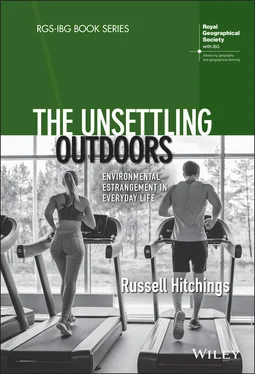On that point, others have emphasised the importance of acknowledging the continued geographical bias in studies of greenspace benefits. This has led researchers to overlook certain important parts of the puzzle. Specifically, because many studies have been done in relatively temperate climates, the outdoor discomforts that are likely to be more keenly felt elsewhere in the world are often downplayed (Keniger et al. 2013). In other words, these studies tend to picture ‘the outdoors’ as a pleasant environment in which to linger such that those who do so will soon start to reap the restorative benefits provided by greenspace. Sometimes this is even part of the research design when studies have attempted to control for these ‘contextual’ climatic matters in order to study the effects of spending time with greenery in a more scientific way (see, for example, Bamberg, Hitchings, and Latham 2018). Yet, in very many cities around the world, it is often simply too hot, too cold, too sticky or too windy to make it an attractive proposition to sit outside and start accruing the benefits that feasibly flow from living vegetation in parks. It is a straightforward, but no less important, point that, if the people involved are rained on, or they start to sweat, they might soon leave (and potentially resolve never to spend time in such ‘irritating’ environments again).
If we turn to a different reading of the persistent effects of our evolutionary past, we are encouraged to see another set of reasons to be reticent about lingering for too long in these spaces. Whilst humans may very well be fundamentally attracted to particular vistas and the presence greenery, we should not forget how there have often been challenges and threats concealed within. These range from spiders and snakes to irritating plants and stinging insects (Bixler and Floyd 1997). It might therefore make good sense to recoil from these environments and retreat into the sanctuary that was once provided by caves and other forms of basic shelter and is now more commonly found in houses and apartments. Others have developed this thinking by turning to how greenspaces can feel like unpalatable places of ‘risk’ such that many do not go to them because of a background sense that they are insufficiently safe or, returning to the less intense feelings of aversion that Bixler and Floyd point towards, insufficiently sanitised (Skår 2010). Another study has considered how we might feel more relaxed if we can see for a good distance without potential assailants seeing us – viewed in this way, being immersed in vegetation that can also conceal threats is understandably unappealing (Gatersleben and Andrews 2013).
What should be done about this? If we accept that there is more to this issue that providing attractive urban parks, what other solutions are there? One novel response is to think about how comparable experiences and benefits could be provided indoors. Could getting people to look at greenery on screen (or experience it through virtual reality) have the same effects? Perhaps for older people in ageing societies this could be a particularly good idea when the real-world equivalents can be physically daunting for this group (Depledge, Stone, and Bird 2011)? However, such a strategy could also push those involved even further away from the outdoors by giving them everything they need from nature inside. Presenting dramatic natural environments on screen might furthermore make the local outdoor reality increasingly dull by comparison (Ballouard, Brischoux, and Bonnet 2011). Building on the idea that we need to engage with, rather than ignore, the changing ways in which people are living in cities, another suggestion is that policymakers might do better to focus on making greenspace easier for people to encounter without making active choice to go to parks and gardens. Perhaps we should focus on the ‘incidental’ interactions associated with where they already walk, work and live (Cox et al. 2017a).
In a study that suggests those Australians who go to urban parks are doing so because of their personal affinity with these places more than the proximity to their homes – what they call the tension between ‘orientation’ and ‘opportunity’ –the logical conclusion is that we should encourage the affinity (Lin et al. 2014). For these authors, that means potentially undertaking a kind of ‘nature awareness training’ for young people so that this affinity is established in these early years. The hope is that this will stand them, and wider society, in good stead as they grow up. Indeed, children have been a particular target for this kind of argument, connecting to anxieties about what others have called ‘nature deficit disorder’ (Louv 2005) – the idea that, because many modern children don’t play outdoors as previous generations apparently did, they are already suffering as a result. Soga and Gaston (2016), for example, float the suggestion that parents should perhaps be making the effort to force their children outside (once there, they’ll soon get used to it, and soon start to like it). Could that eventually turn the tide on the broader cultural turn away from greenspaces that these studies worry about? And if we succeeded, as a number have considered, then benefits may not only be accrued by the individuals involved. Indeed, there is, in fact, some evidence that the result could be a greater sense of care for the natural environment, a stronger commitment to conservation and an increased interest in the health of the planet. Staying with the focus on contemporary young people, if one of the biggest challenges relates to how attractive ‘screen time’ has become to them (Larson et al. 2018), perhaps smartphone apps could help (Dorwood et al. 2017)? Either way, the concern here is that, if many young people are increasingly cocooned from outdoor experiences, they could quite easily become unaware of what is happening in the wider environment at a range of scales (from global climate change to local biodiversity loss). And soon that could be too late to fix.
It can be tempting to see young people as the obvious focus for attempts to tackle this problem (in the hope that they will somehow escape the challenges currently faced by the rest of us when they grow up). Indeed, the whole discipline of environmental education is essentially predicated on this idea. Within it, and regardless of where wider lifestyles seem to be headed in many places, it has become quite common to buy into the suggestion of ‘getting them early’ and then hoping for the best (Collins and Hitchings 2012). Yet, it is entirely possible that today’s young people will be socialised into future societies that are even less inclined to linger in greenspaces, irrespective of our attempts to get them bitten by the greenspace bug in their relative infancy (Asah, Bengston, and Westphal 2012). Indeed, if we think life course is important, perhaps we should consider how people move through other stages that each present their own opportunities and challenges in terms of establishing an affinity with the natural world (Bell et al. 2014). Then there is the much-vexed matter of how some ethnic groups feel that public greenspaces are not really for them, partly because they often congregate in parts of the city where they are comparatively uncommon (Gentin 2011). We have also seen studies exploring how women have particular ideas about the forms of urban greenspace in which they feel sufficiently safe and comfortable (see Krenichyn 2004). Others have also considered how those living in disadvantaged areas may particularly benefit from nearby greenspace (potentially acting as a kind of buffer to dissipate the stresses of experienced financial hardship) (Ward Thompson et al. 2016), and how older people might feel that they gain as much from viewing greenery from their homes as going out into it (Day 2008).
Читать дальше












